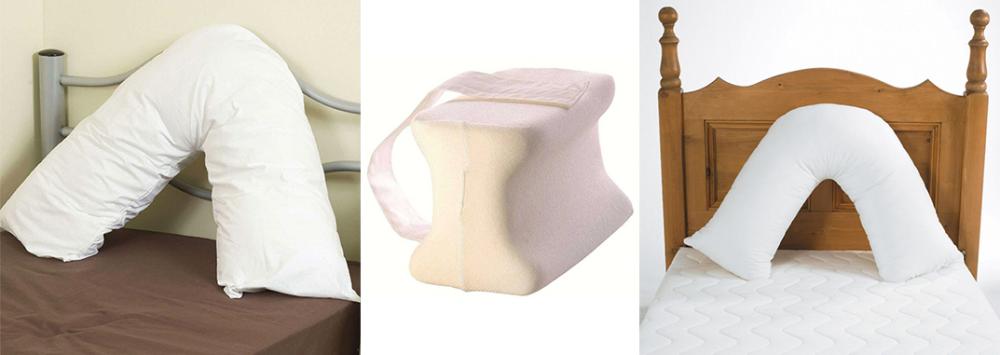
Pillow Power and Well Being
Sally Madeley-Carr, OT23 Sep 2021
Quality of sleep has a big impact on your performance during the day. To achieve good quality of sleep, you need enough hours, a comfortable sleeping position and the right pillow support.
The irregularity of the human body form means that, when lying down, support is not given to the whole body the whole of the time.
Moving During the Night
People choose to sleep in different positions and, starting off in their sleep-inducing position, will move into different positions during the night.
- Sleeping on your Back
Sleeping on your back, a regular pillow supports the head in a slightly raised position, to bring your head and neck in line with your shoulders. Having no pillow could lead to head and neck pain the following morning.
Sleeping on your back is a good position, as it holds the organs of your body in their rightful places and keeps the spine straight.
Sleeping on your back helps to protect your spine and may also relieve pressure on your hip and knee.
- Lying on Your Side
Lying on one's side may need a second or third pillow, to raise your head and neck from the lowered position it may find itself in.
Lying on your side puts pressure on that side of your face and can cause a swifter move towards facial wrinkles.
When sleeping on your side, the thickness of your pillow is of paramount importance. If it is too thin or too thick, it will not align your head and neck with the natural position of the spine.
Sleeping on your side places added pressure on that side of your body. With your hip and leg pressing against the mattress, this may disrupt circulation, resulting in tingling and pain, as well as erectile dysfunction.
Side sleeping can also put pressure on your heart and lungs, as well as your stomach.
There is evidence that sleeping on your side helps drain your lymphatic system more efficiently and this could give protection against Parkinson's disease and Alzheimer's.
- The Left Side
Lying on one's left side may also put pressure on the heart and lungs, as the body struggles to find total support for the curvature between the shoulder and hip bone. Repositioning your heart could cause your heart to turn and could affect natural electrical activity.
There is no evidence that lying on your left side increases your chances of developing a heart condition.
- The Right Side
Sleeping on your right side can cause acid to pass through your oesophagus, causing acid reflux.
- Lying on Your Front
Lying on one's front brings on the need for the head to be twisted to the left or right, causing stress on the neck itself.
When sleeping on your stomach, it works against the natural curvature of your spine (forcing it to flatten) and gives added pressure to the spine's muscles and joints.
Getting it Right
The position you choose to sleep in may affect your joints and could also affect how your body rids itself of toxins.
Though we place little thought on the pillow we use, getting the right size, thickness, firmness and even shape can positively affect quality of sleep and health.
Don't sleep with your shoulders also on the pillow, as this worsens the tilt of your head by lifting your whole upper body and leaving your head curved backwards. This position will cause more head and neck pain.
Sleeping in an uncomfortable position can add more stress to joints and connective tissues.
Beds Aren't Only for Sleeping In
Whilst a bed is primarily thought of as simply where you sleep, sitting up in bed might be a chosen position for eating and drinking, reading, knitting, watching television and talking to others via the computer and mobile systems e.g. Skype, Zoom and Face Time.
If not sitting in the very uncomfortable position of having one's legs crossed, sliding down the bed from that sitting position can be extremely annoying. Bending your legs at the knees can help you anchor yourself but gives no real scope for taking advantage of that position to carry out other tasks or needs.
For elderly people with weaker frames, and for people recovering from illness, sitting up in bed will be a longed for position, keeping you more in touch with the active world around you.
Pillow Support
When sitting up in bed, your upper body is upright and supporting your neck and head, or your head is resting against the wall or on the bed headboard. For more mature people, or those recovering from illness, maintaining this sitting position over a period of time, and without some form of support, will cause irritability and pain.
Pillows come in different sizes and shapes, are made of different materials and have different levels of softness and firmness. Pillows are so designed to do what they claim to do. Two specifically designed pillows are the v pillow and the knee pillow / knee cushion.
- Why is a V Pillow Different?
As named, a v' pillow' is 'v' shaped and its form can stop you rolling over into a different position when you are sleeping. This can therefore promote quality sleeping for your partner as well, who will sleep better without constant interruptions.
A v pillow is firm enough to fully support your head and soft enough to alleviate pressure.
When the v pillow is laid flat on the bed with the v in the uppermost position, it lifts your head and neck into alignment with your shoulders and so prevents head and neck pain.
Having your head supported in a somewhat fixed position, lying on your back will keep facial wrinkles at bay, as the side of your face is not being rested upon for hour upon hour.
When sitting in a chair, wrapping a v pillow around your waist area can relieve pain in your lower back and give you a more sturdy sitting position.
Placing this pillow between your legs when sleeping will help keep pressure off your knees and lumbar spine, by keeping your body aligned.
A v pillow can also be used on top of a regular pillow, raising your head a little higher if you're already experiencing a stiff neck.
For those with COPD (chronic obstructive pulmonary disease), coughing during the night can be alleviated by raising one's head via a v pillow. This position leads to opening the airways, clearing blockages and easing breathing.
Raising your head also helps relieve congestion with such illnesses as cold, flu, asthma and bronchitis.
You can relieve back pain by placing the v pillow under your knees.
V pillows can be made from various materials, including feather, memory foam, polyester and latex.
The v shaped pillow prevents tossing and turning and so helps protect your spine, whilst reducing back pain.
When trying to read in a semi-relaxed position, the v pillow can support your head and neck and provide sufficient supported tilt, both in bed and on the sofa. Watching TV can also be achieved from that well-supported, semi-recumbent position.
- The Knee Pillow / Knee Cushion
A knee pillow can get the hips into alignment and support the upper leg, taking a lot of strain off your knees.
Some knee pillows are wedge-shaped and both support your legs and keep your knees in place.
Knee pillows made of memory foam give the best support, as your body heat encourages the memory foam to mould to your shape and needs.
Knee pillows should be firm and stop your knees from constantly touching each other.
- Knee Pillow Support and Sciatica
The sciatic nerves run to the base of your lower back, hips and legs and so, when your body is not suitably aligned, you can develop sciatica.
If your hips fall out of alignment (e.g. one leg further forward during sleep than the other), this can place added tension on the sciatic nerves and have you experiencing tingling and numbness in the lower part of the body.
Keeping the body aligned is of major importance for both a good night's sleep and for your health. A knee pillow is designed specifically with the task of keeping the knees, legs, hips and spine aligned with each other.
Keeping Pillows Clean
Pillows must be washed at least twice a year, to keep them free from dust and mites and to prevent the worsening of allergies:-
- Down, cotton and synthetic - machine-washable, these pillows take quite some time to dry
- Latex foam and memory pillows - these need to be washed by hand and then dried quickly, to prevent mould from developing. These pillows can also be dry-cleaned.
If you are a frequent user of the v pillow, the cover itself needs to be washed at least once a week.
Summary
A good sleeping position promotes quality of sleep.
Sleeping on your back is a good position, as it holds the organs of your body in their rightful places and keeps the spine straight.
When your hips aren't aligned, they pull on your spine and strain the ligaments.
Aligning your body improves circulation.
The v pillow supports your head and neck and can prevent you rolling over during the night.
Sleeping on your back helps to protect your spine.
Sleeping in an uncomfortable position can add more stress to joints and connective tissues.
Reducing lower back pain will make it easier for you to move around in the morning.

Sally Madeley-Carr, OT
Sally qualified as an Occupational Therapist in 1996 and is a well-respected professional in the field of rehabilitation equipment and living aids. She has worked in private practice and within the NHS, developing a broad experience with adults and children. Click here for Sally's registration with the Health and Care Professions Council. The HCPC regulates health, psychological and social work professionals in the UK.